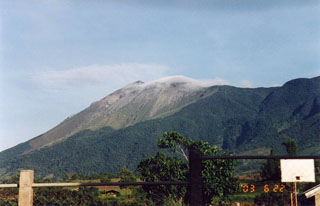Report on Kanlaon (Philippines) — 13 December-19 December 2017
Smithsonian Institution / US Geological Survey
Weekly Volcanic Activity Report, 13 December-19 December 2017
Managing Editor: Sally Sennert.
Please cite this report as:
Global Volcanism Program, 2017. Report on Kanlaon (Philippines) (Sennert, S, ed.). Weekly Volcanic Activity Report, 13 December-19 December 2017. Smithsonian Institution and US Geological Survey.
Kanlaon
Philippines
10.4096°N, 123.13°E; summit elev. 2422 m
All times are local (unless otherwise noted)
PHIVOLCS reported between 1 and 7 volcanic earthquakes at Kanlaon were recorded each day during 2-8 December, prior to the phreatic eruption on 9 December. Only three events were detected on 10 December, and then the number increased to 155 the next day. The number of daily volcanic earthquakes increased to 578 on 13 December, rising to 1,007 the next day, and peaking at 1,217 on the 15th. The earthquake count dropped to 149 on 16 December before returning to six or less through 19 December. White steam plumes rose 800 and 300 m above the crater on 13 and 14 December, respectively. White plumes were diffuse on 15 December; weather clouds prevented views of the summit area during 16-18 December. Sulfur dioxide emissions were 603-687 tons per day during 13-14 December. The Alert Level remained at 2 (on a scale of 0-5).
Geological Summary. Kanlaon volcano (also spelled Canlaon) forms the highest point on the Philippine island of Negros. The massive andesitic stratovolcano is covered with fissure-controlled pyroclastic cones and craters, many of which are filled by lakes. The largest debris avalanche known in the Philippines traveled 33 km SW from Kanlaon. The summit contains a 2-km-wide, elongated northern caldera with a crater lake and a smaller but higher active vent, Lugud crater, to the south. Eruptions recorded since 1866 have typically consisted of phreatic explosions of small-to-moderate size that produce minor local ashfall.
Source: Philippine Institute of Volcanology and Seismology (PHIVOLCS)

